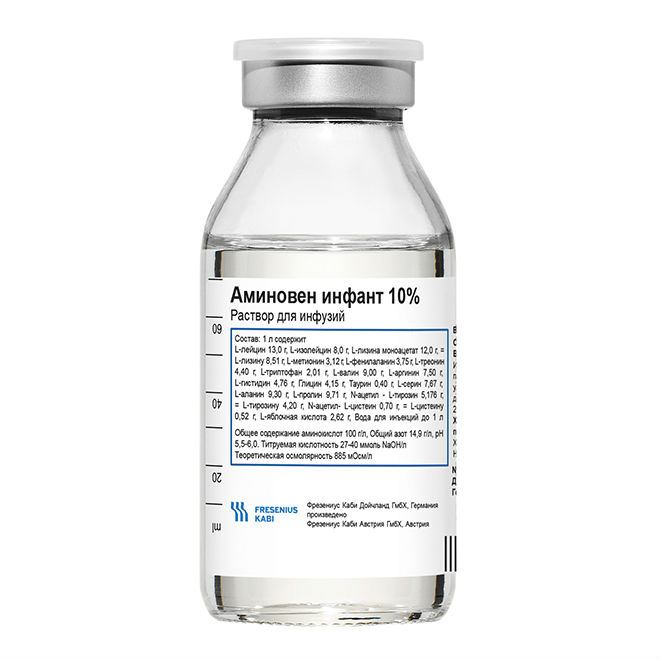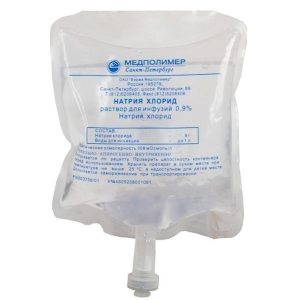Description
Packing
Bottle 100 ml.
Pharmacological action
Aminoven infant – a drug for parenteral nutrition (amino acid solution).
The amino acids that are part of the Aminoven infant infant are natural physiological components. After parenteral administration, they are included in the pool of free amino acids of the body and participate in all metabolic processes, in particular, are used for protein synthesis.
The concentration of free amino acids in blood plasma and cytoplasm of cells is regulated within a narrow range depending on the age, nutritional status and general condition of the patient. When administered correctly (slowly and at a constant speed), the Aminoven infant does not upset the balance of amino acids. In severe violations of the liver and kidneys, the regulation of amino acid balance is disturbed. In these cases, special prescriptions of amino acid solutions for parenteral nutrition should be used. Only a small fraction of the amino acids is eliminated by the kidneys. The half-life of plasma amino acids is largely dependent on age.
Indications
Aminoven infant is intended for partial parenteral nutrition of newborns, young children and premature infants. Together with carbohydrate solutions, fat emulsions, as well as preparations of vitamins, electrolytes and trace elements, it provides complete parenteral nutrition.
Contraindications
Disorders of amino acid metabolism
hyperhydration
hypokalemia
metabolic acidosis.
In case of liver and kidney failure, individual dosing is required.
Special instructions
Dosage adjustment is required in patients with impaired liver and / or kidney function. With severe hepatic or renal failure, regulation of the balance of amino acids is disturbed. In these cases, special solutions of amino acids for parenteral nutrition should be used.
For parenteral nutrition in young children, the following indicators should be monitored: urine nitrogen, ammonia, glucose, electrolytes, triglycerides (with the addition of fat emulsions), liver enzyme activity, serum osmolarity, acid-base balance and water-salt metabolism.
Too fast infusion can lead to the rapid elimination of amino acids through the kidneys, and therefore to an imbalance of amino acids.
Amino acid solutions due to the increased risk of microbial contamination should not be mixed with other drugs. An open bottle with the drug Aminoven infant 10% should be stored in the refrigerator for no more than 24 hours.
Avoid the addition of drugs not intended for parenteral nutrition. In any case, you need to make sure the compatibility of the drugs, maintaining sterility and thorough mixing.
Composition
Active substances: L-leucine – 1.30 g L-isoleucine – 0.80 g L-lysine monoacetate – 1.20 g L-lysine – 0.851 g L-methionine – 0.31 g L-phenylalanine – 0.375 g L-threonine – 0.44 g L-tryptophan – 0.221 g L-valine – 0.90 g L-arginine – 0.750 g L-histidine – 0, 476 g Glycine – 0.415 g Taurine – 0.040 g L-serine – 0.767 g L-alanine – 0.93 g L-proline – 0.971 g L-tyrosine – 0.42 g N-acetyl-L-cysteine ??- 0.07 g L-cysteine ??- 0.052 g L-malic acid – 0.262 g
Dosage and administration
Aminoven infant is administered intravenously, slowly, mainly into the central veins. Maximum infusion rate: 100 mg of amino acids per 1 kg of body weight per hour, which corresponds to 1.67 ml of Aminoven Infant 6% solution or 1 ml of Aminoven Infant 10% solution.
Maximum daily dose: for children up to 1 year old – 1.5-2.5 g of amino acids per 1 kg of body weight (15-25 ml of Aminoven Infant 10% solution)
for children aged 2 – 5 years – 1.5 g of amino acids per 1 kg of body weight (15 ml of Aminoven infant 10% solution).
for children aged 6-14 years – 1.0 g of amino acids per 1 kg of body weight (10 ml Aminoven infant 10%).
aminoven infant applies as long while there remains a need for parenteral nutrition.
Side effects
Local reactions: when introduced into peripheral veins, hyperemia, phlebitis, thrombosis at the injection site are possible.
Overdose
Symptoms: if the dose or rate of administration is exceeded, chills, nausea, vomiting, and renal aminoacidosis may cause acute circulatory disorders.
Treatment: drug administration should be stopped immediately. When hyperkalemia occurs, 200 to 500 ml of 5% glucose solution should be administered with 1-3 IU of insulin for every 3-5 g of glucose.
Storage conditions
Do not store above 25 ° C in a dark place. Do not freeze. Keep out of reach of children.
Expiration
2 years.
Effective
Amino substance for parenteral nutrition
Terms leave through pharmacies
In retseptu
Dosage form
solution for infusions
Prescribing
Prescribing children
Fresenius Kabi, Germany




